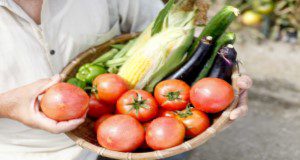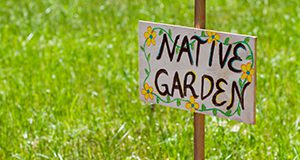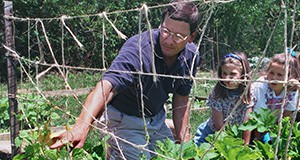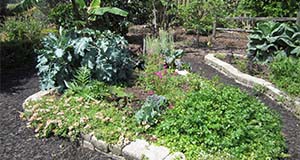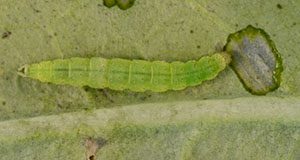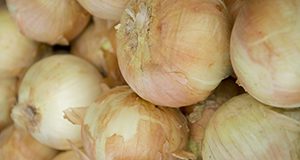
Sweet varieties of bulbing onions, which make bulbs under short day conditions and do not store well, are by far the most common onions grown in Florida. They are generally grown on small acreages in the winter for local and farmers markets. In Hillsborough County and in the Suwannee Valley, strawberry growers are the major producers of onions, many of which are harvested green. This 2-page fact sheet written by Xavier Martini and Susan Webb and published by the UF/IFAS Entomology and Nematology Department reviews the management of the two major onion pests in Florida: thrips and seedcorn maggot.
https://edis.ifas.ufl.edu/ig153
Tag: Susan Webb
Guía para Cultivar Vegetales en la Florida
El desarrollo y planificación de un huerto en el hogar, es una actividad agrícola que puede realizarse durante todo el año en Florida. Puede ofrecer muchos beneficios para la salud física y emocional. Los huertos nos proveen alternativas para realizar ejercicios, disfrute del huerto, producción de vegetales frescos y nutritivos, ahorro económico y muchos otros. Esta guía proporciona recomendaciones para hacer un huerto en su residencia y comunidad, e incluye las fechas de siembra, la selección de variedades para la planificación de cultivos, el manejo de agua, nutrientes, plagas y la cosecha.
This is a translation of SP103/VH021, Florida Vegetable Gardening Guide. Written by Sydney Park Brown, Danielle Treadwell, J. M. Stephens, and Susan Webb; translated by Francisco Rivera; and published by the UF/IFAS Horticultural Sciences Department.
https://edis.ifas.ufl.edu/hs1383
Key Program Outcomes for K-12 School Gardens Identified Through Expert Consensus
National trends indicate that school gardens are positioned to become fixtures in primary and secondary education. This 4-page document outlines key outcomes identified through expert consensus that can be used by Extension professionals to develop a logic model for the school garden program. Written by Susan Webb, John Diaz, and Catherine Campbell and published by the UF/IFAS Department of Agricultural Education and Communication, September 2018.
http://edis.ifas.ufl.edu/wc312
Understanding the Barriers for School Garden Success: Expert Consensus to Guide Extension Programming
Research has found that youth involvement in school gardens leads to numerous benefits. However, teachers and support organizations must overcome barriers for garden sustainability. This 4-page document discusses barriers for school garden success and how Extension faculty can help education professionals overcome them. Written by Susan Webb, John Diaz, and Catherine Campbell and published by the UF/IFAS Department of Agricultural Education and Communication, August 2018.
http://edis.ifas.ufl.edu/wc315
Stakeholder-Identified Barriers, Challenges, and Obstacles in Community Gardens
Florida Extension agents play a vital role in assisting community members to start and sustain community gardens through site visits, workshops, and educational events. This 3-page document discusses the results of a Delphi study conducted in order to create a picture of the barriers, challenges, and obstacles to starting and sustaining community gardens in Florida. Written by Susan Webb and John Diaz and published by the UF/IFAS Department of Agricultural Education and Communication, March 2018.
http://edis.ifas.ufl.edu/wc301
Stakeholder-Identified Community Garden Program Outcomes
Extension clientele often contact agents for expertise on starting or maintaining a community garden; however, agents’ ability to collect meaningful data from these activities can be a challenge. This 3-page publication discusses a statewide study that was conducted by the author to identify community garden outcomes. Written by Susan Webb and John Diaz and published by the UF/IFAS Department of Agricultural Education and Communication, January 2018.
http://edis.ifas.ufl.edu/wc295
Manejo de Insectos en Cruciferas (Cultivos de Coles) (Brocoli, Repollo, Coliflor, Col, Col Rizada, Mostaza, Rabano, Nabos)
Los vegetales conocidos como crucíferas son un grupo de cultivos amplio y cada vez más importante en Florida. Un número de insectos se alimenta exclusivamente de crucíferas y afecta todos los cultivos enlistados en el título.
This thirty-page fact sheet is the Spanish translation of IG150: Insect Management for Crucifers (Cole Crops). Written by S.E. Webb, A. Nino, y H.A. Smith and published by the Entomology and Nematology Department.
http://edis.ifas.ufl.edu/ig168
Florida Vegetable Gardening Guide — Revised!
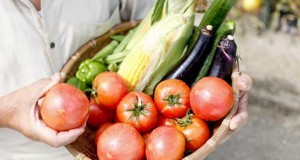
Vegetable gardening offers fresh air, sunshine, exercise, enjoyment, mental therapy, nutritious fresh vegetables, and economic savings, as well as many other benefits. With some attention to planning and planting, vegetables can be grown year-round in Florida. This 11-page guide provides recommendations primarily for traditional home gardens, including planning your garden and choosing crops, soil preparation and maintenance, fertilization, irrigation, pest management, and other gardening know-how. Includes a planting guide, table of suggested varieties, and table of products labeled for insect and mite management in home vegetable gardens. Written by Sydney Park Brown, Danielle Treadwell, J. M. Stephens, and Susan Webb, and published by the Environmental Horticulture Department.
http://edis.ifas.ufl.edu/vh021
Minimizing Honey Bee Exposure to Pesticides
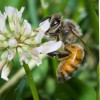 Protecting honey bees and other pollinators from pesticide impacts is important to the sustainability of agriculture. Consequently, pesticide applicators must determine if there is a clear hazard to managed or wild populations of bees. Potential exposure of bees to pesticides can vary greatly depending on the type of pesticide, formulation, application method, label restrictions, and other factors. The goal in using a pesticide is to achieve maximum benefit (success) with minimum negative impact, and these factors should always be considered in pesticide selection. This publication is written (1) to help assure the sustainability of both bees and agriculture by informing beekeepers, pesticide users, and the general public about the often complex relationship between pollinators (specifically bees) and pesticides, (2) to offer guidance for improved communication between beekeepers and pesticide users, (3) to offer pollinator risk-reducing strategies for growers and other applicators when using pesticides, and (4) to provide clarity in laws, labeling, and associated definitions. This 14-page fact sheet was written by J. D. Ellis, J. Klopchin, E. Buss, F. M. Fishel, W. H. Kern, C. Mannion, E. McAvoy, L. S. Osborne, M. Rogers, M. Sanford, H. Smith, P. Stansly, L. Stelinski, and S. Webb, and published by the UF Department of Entomology and Nematology, March 2014.
Protecting honey bees and other pollinators from pesticide impacts is important to the sustainability of agriculture. Consequently, pesticide applicators must determine if there is a clear hazard to managed or wild populations of bees. Potential exposure of bees to pesticides can vary greatly depending on the type of pesticide, formulation, application method, label restrictions, and other factors. The goal in using a pesticide is to achieve maximum benefit (success) with minimum negative impact, and these factors should always be considered in pesticide selection. This publication is written (1) to help assure the sustainability of both bees and agriculture by informing beekeepers, pesticide users, and the general public about the often complex relationship between pollinators (specifically bees) and pesticides, (2) to offer guidance for improved communication between beekeepers and pesticide users, (3) to offer pollinator risk-reducing strategies for growers and other applicators when using pesticides, and (4) to provide clarity in laws, labeling, and associated definitions. This 14-page fact sheet was written by J. D. Ellis, J. Klopchin, E. Buss, F. M. Fishel, W. H. Kern, C. Mannion, E. McAvoy, L. S. Osborne, M. Rogers, M. Sanford, H. Smith, P. Stansly, L. Stelinski, and S. Webb, and published by the UF Department of Entomology and Nematology, March 2014.
http://edis.ifas.ufl.edu/in1027
Organic Vegetable Gardening in Florida
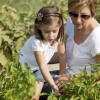 This 16-page fact sheet is meant to be a companion to the Florida Vegetable Gardening Guide. It is intended for the home gardener who prefers to use natural and organic materials as well as methods that are compatible with the philosophy of organic gardening. was written by Danielle D. Treadwell, Sydney Park Brown, James Stephens, and Susan Webb, and published by the UF Department of Horticultural Sciences, June 2013.
This 16-page fact sheet is meant to be a companion to the Florida Vegetable Gardening Guide. It is intended for the home gardener who prefers to use natural and organic materials as well as methods that are compatible with the philosophy of organic gardening. was written by Danielle D. Treadwell, Sydney Park Brown, James Stephens, and Susan Webb, and published by the UF Department of Horticultural Sciences, June 2013.
http://edis.ifas.ufl.edu/hs1215
Pesticide Options for Insect, Mite, and Mollusk Management in Commercial Strawberry Production in Florida (ENY689/IN486)
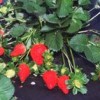 Effective management of arthropod and gastropod pests of strawberry is critical to the profitability of the industry and requires that pests be detected in a timely manner through systematic scouting. Appropriate control measures should be applied as conditions warrant. The tables in this 22-page fact sheet list pesticides that are presently available to commercial strawberry producers in Florida and are organized alphabetically by major pest groups. Written by James F. Price, Curtis Nagle, and Susan E. Webb, and published by the UF Department of Entomology and Nematology, April 2013.
Effective management of arthropod and gastropod pests of strawberry is critical to the profitability of the industry and requires that pests be detected in a timely manner through systematic scouting. Appropriate control measures should be applied as conditions warrant. The tables in this 22-page fact sheet list pesticides that are presently available to commercial strawberry producers in Florida and are organized alphabetically by major pest groups. Written by James F. Price, Curtis Nagle, and Susan E. Webb, and published by the UF Department of Entomology and Nematology, April 2013.
http://edis.ifas.ufl.edu/in486
Insecticides Currently Used on Vegetables (ENY419/IG018)
 This 12-page fact sheet lists many of the common insecticides currently labeled for use on vegetables in Florida. A number of new materials have been registered in the past few years or have had additional crops added to their labels. Some older organophosphate insecticides are now restricted to just a few crops, a result of recent rulings related to the Food Quality Protection Act. Changes continue, thus this listing may not be totally accurate at the time of printing. Written by S. E. Webb and P. A. Stansly, and published by the UF Department of Entomology and Nematology, August 2012.
This 12-page fact sheet lists many of the common insecticides currently labeled for use on vegetables in Florida. A number of new materials have been registered in the past few years or have had additional crops added to their labels. Some older organophosphate insecticides are now restricted to just a few crops, a result of recent rulings related to the Food Quality Protection Act. Changes continue, thus this listing may not be totally accurate at the time of printing. Written by S. E. Webb and P. A. Stansly, and published by the UF Department of Entomology and Nematology, August 2012.
http://edis.ifas.ufl.edu/ig018
Recommendations for Management of Whiteflies, Whitefly-transmitted viruses, and Insecticide Resistance for Production of Cucurbit Crops in Florida (EENY478/IN871)
 Until recently, squash has been the only cucurbit crop seriously affected by the B biotype of the sweetpotato whitefly, also known as the silverleaf whitefly, because of the silverleaf disorder induced by feeding of the immature stages (nymphs). However, three viruses transmitted by the whitefly have been identified in watermelon, muskmelon, and squash in Florida since 2004, making whitefly management a priority for most cucurbits. This 8-page fact sheet details the current UF/IFAS recommendations for managing whitefly-transmitted viruses and for delaying the development of resistance to insecticides in the whitefly vector. Published by the UF Department of Entomology and Nematology, July 2011.
Until recently, squash has been the only cucurbit crop seriously affected by the B biotype of the sweetpotato whitefly, also known as the silverleaf whitefly, because of the silverleaf disorder induced by feeding of the immature stages (nymphs). However, three viruses transmitted by the whitefly have been identified in watermelon, muskmelon, and squash in Florida since 2004, making whitefly management a priority for most cucurbits. This 8-page fact sheet details the current UF/IFAS recommendations for managing whitefly-transmitted viruses and for delaying the development of resistance to insecticides in the whitefly vector. Published by the UF Department of Entomology and Nematology, July 2011.
http://edis.ifas.ufl.edu/in871
HS798/CV274 Vegetable Insect Identification and Management – Florida
Revised! HS798, a 24-page guide by S. E. Webb and R. C. Hochmuth, provides instruction in management and control of insects and mites in greenhouse vegetable production — crop scouting and monitoring, identification of insects and mites, record keeping, management strategies and tactics, banker plant system, insecticides and miticides, storage of pesticides, safety, and control of specific greenhouse pests. Includes references. Published by the UF Department of Entomology and Nematology, June 2010.
http://edis.ifas.ufl.edu/cv274
SP103/VH021 Florida Vegetable Gardening Guide
Revised! SP-103, a 12-page fact sheet by J.M. Stephens, Sydney Park Brown, Danielle Treadwell, Susan Webb, Amanda Gevens, R.A. Dunn, G. Kidder, D. Short, and G.W. Simone, provides research-based recommendations appropriate for home gardens. It covers planning, soil preparation, compost and fertilizing, irrigation and drainage, and pest management with and without pesticides. Includes tables with fertilizer and insectic control recommendations, a planting guide with planting dates and spacing information, and a table of varieties recommended for Florida gardens. Published by the UF Horticultural Sciences Department, February 2009.
http://edis.ifas.ufl.edu/VH021
